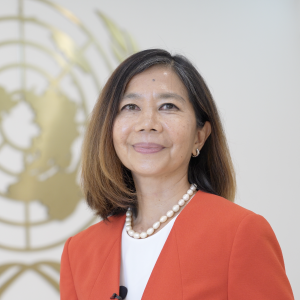- Dr. Le Viet Anh, Director General, Department of Science, Education, Natural Resources and Environment, Ministry of Planning and Investment;
- Mr. Vatcharin Sirimaneetham, Chief of Macroeconomic Policy and Analysis Section, UNESCAP;
- Honourable Government Delegates, Development Partners, Distinguished Guests
I thank you for your time and engagement in today’s Consultation Workshop on “Accelerate Sustainable Development in Viet Nam: Policy Options”. I am keen to learn and exchange with you today.
First and foremost, I convey my sincere appreciation to our key partner, Ministry of Planning and Investment (MPI) and particularly Department of Science, Education, Natural Resources and Environment (DSENRE). Without MPI’s fruitful and close collaboration with UN ESCAP and the UN in Viet Nam in conducting a joint macroeconomic modelling exercise, we would not be here today.
Colleagues,
Viet Nam has made great strides in improving the living standards and lifting millions of people out of poverty. Building on these remarkable achievements, the leaders of Viet Nam has set a vision to become a high-income country by 2045 and realize net-zero emissions by 2050. This vision drives Viet Nam’s commitment to achieve the 2030 Agenda for Sustainable Development and the Sustainable Development Goals (SDGs).
Viet Nam’s second Voluntary National Review (VNR) presented by HE Nguyen Chi Dung, MPI Minister at the High-Level Political Forum (HLPF) in July, already outlined six policy priorities and recommendations for SDG acceleration. They are: science, technology and innovation; quality human resource development; efficient resource management, climate change adaptation and mitigation, and green and circular economy; finance; and data availability, with people at the center of every decision, policy, and action.
These priorities are well aligned with the six SDG transitions agreed by member states at the SDG Summit -- envisioned to generating large multiplier effects across SDGs to promote economic prosperity, while protecting human and environmental wellbeing.
You may recall, the 6 transitions are on: Jobs and Social Protection, Energy, Education, Food Systems, Digital, as well as in Biodiversity and Nature Protection. Viet Nam’s SDG acceleration priorities also commits to means of implementation: in finance, data and public sector capabilities.
So how is the macroeconomic modelling going to help in taking forward Viet Nam’s SDG acceleration priorities?
This joint UN-GoV macroeconomic modelling is a follow up to Viet Nam’s VNR exercise. The modelling helps answer questions about how the government’s investments in national sustainable development priorities, such as investments in renewable energy, might affect economic, social and environmental outcomes, such as GDP growth, poverty rate and CO2 emissions.
The exercise has generated empirical evidence on the synergies and trade-offs for investments in energy transition, social protection, education and digital transformation. The results of the modelling exercise help to make informed decisions on policy choices and interventions.
I will leave the technical details in the hands of our capable team from MPI, UNESCAP and RCO to elaborate on. I highlight three initial takeaways to inspire further discussion:
- First, investment in renewable energy propels GDP growth by 3%, while substantially reducing CO2 emissions and pollution.
- Second, investment in human capital and energy efficiency-focused infrastructure has positive economic and social effects in the long run. It drives GDP growth, reduces poverty and inequality, lessens CO2 emission and pollution, and improves the government’s fiscal space because GDP growth outweighs the government debt increase.
- Third, investment in digital transformation has a positive effect on GDP growth, albeit relatively moderate, as well as on poverty reduction and inequality.
In sum, results of the modeling show that investing in people and the environment yields significantly positive economic and social benefits in the long run, while the pressures on the government’s fiscal space subside over time because the economic benefits outweigh the costs. It also highlights the importance of mobilizing various sources of finance, including private capital, to invest in key development priorities.
Our hope is that this macro-modeling exercise provides relevant evidence for crafting policy pathways suitable for Viet Nam to accelerate SDG transformations and to ensure that they are just and equitable.
Thank you! Xin cam on!


















